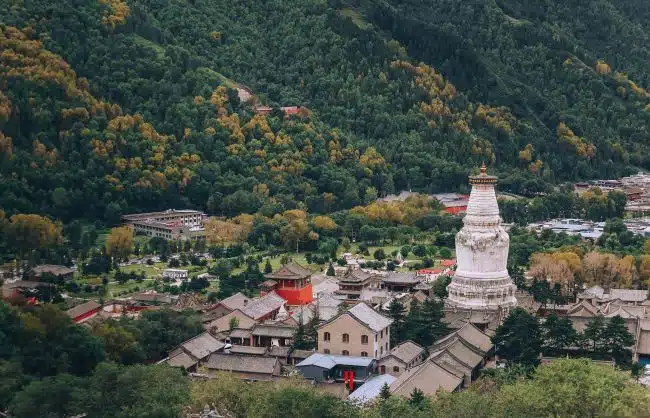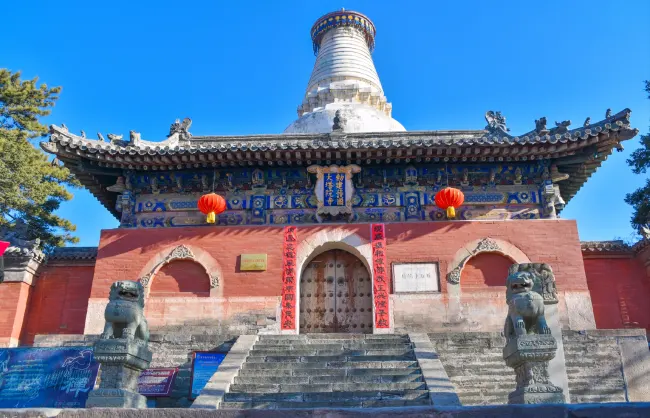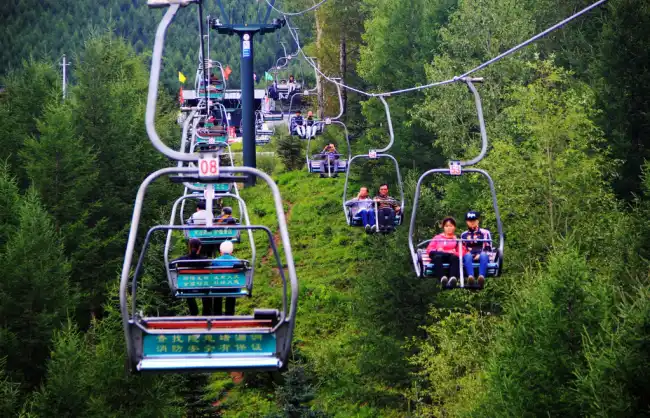Wutai Mountain, also known as Qingliang Mountain, in Shanxi Province, China, is a national key scenic spot integrating natural scenery and Buddhist culture. Wutai literally meaning five terraces, refers to its five peaks which are tall but flat. They symbolize the five wisdoms of Manjusri, the bodhisattva of wisdom.
Wutai Mountain is ranked top of the four most famous Buddhist mountains in China, together with Mount Emei of Sichuan, Jiuhua Mountain of Anhui, and Mt Putuo in Zhejiang. Its rich history, religious significance, and gorgeous natural scenery have earned it the title of a UNESCO World Heritage Site.
Fast Facts about Wutai Mountain
- Location: Wutai County, Xinzhou City, Shanxi Province; about 240 km (150 miles) from Taiyuan
- Altitude: 3,061.1 meters (10,043 feet)
- Hours: 8 am-5 pm (may vary for different temples)
- Tickets: CNY 135for the main scenic area entrance
- Recommended Visit Time: 2-3 days
- Best Time to Visit: June to November
- Suited to: Buddhist pilgrims, culture and nature lovers, photographers

Buddhist History of Wutai Mountain
The first temple built in Wutai Mountain is what’s called Xiantong Temple today, in 68 BC. Over the following dynasties till the Tang, as Buddhism became prevalent in China, a large number of temples and other religious sites were constructed. Buddhist worship and pilgrimage to Wutai Shan Mountain can be dated back to the 5th century.
In Tang dynasty, China became the center of trade and culture in Asia. By that time, Wutai Mountain had become the most brilliant ancient Buddhist architectural complex in East Asia with more than 360 temples. There were even groups of Buddhist followers from India, Japan, Sri Lanka, and other nearby countries that came here to exchange ideas.
However, as the influence of Buddhism gradually waned from 854 AD, today, there are 68 temples left and about 30,000 Buddha statues at Wutai Shan Mountain. But undoubtedly, it is still a sacred site for the countless visitors who travel to Shanxi to witness its magnificence.
Sacred Buddhist Sites of Wutai Mountain
1. Xiantong Temple
Xiantong Temple was the first structure in Wutai Mountain and one of the earliest temples in China. It is the most significant religious site in the mountain and is also large in size. It covers an area of about 80,000 square meters (861,113 square feet), with more than 400 buildings, most of which were built during the Ming and Qing Dynasties.
Among them, the Copper Hall constructed in 1610, was built with a total of 50,000 kilograms of copper. It is one of China’s best-preserved copper halls. There are also more than ten thousand Buddha statues inside the temple.
2. Bodhisattva Monastery
Bodhisattva Monastery is a gorgeous Tibetan Buddhist complex with over 430 halls and palaces. It is a magnificent sight to behold with royal decorations and architectural style. Both Qing Emperors Kangxi and Qianlong stayed here when they visited Wutai Shan Mountain.
3. Tayuan Temple
Tayuan Temple is best known for its Great White Tower, which is regarded by many as the symbol of Wutai Mountain. The tower is 56.3 meters (184.7 feet) tall, and stores the relic of Buddha. That’s why it’s a sacred place to visit for many monks and followers.

Natural Beauty of Wutai Mountain
1. East Terrace – Peak of Sea Viewing
The east terrace is 2,795 meters (9,170 feet) tall. Shanxi Province is nowhere near the coast, but It’s called the Peaking of Sea Viewing because it has an amazing view of the sea of clouds.
Viewing the sunrise on the eastern peak of Wutai Shan Mountain is one of the best things to do here. In summer, a sea of clouds rise above the hills below and the red rising sun floats on its surface. There have been plenty of poetic verses written about this serene experience throughout history.
2. West Terrace – Peak of Hanging Moon
The west terrace, 2,773 meters (9,098 feet) tall, is the most popular choice among hikers. It is known to be the best spot for admiring the moon in Wutai Mountain.
3. South Terrace – Peak of Splendor
The south terrace is also named the Fairy Flower Peak because it is famous for its wild floras. The mountaintop is covered in flowers and weeds. You can find the rare Trollius, Japanese Chrysanthemum, and the precious Tai mushroom which is local to Wutai Shan Mountain.
4. North Terrace – Peak of Flourishing Leaves
3,061 meters (10,043 feet) above sea level, the north terrace is the highest of the five mountains. It tends to get very cold here at the top. It snows in October each year and doesn’t melt until May. Apart from June to September, the temperature is not ideal for hiking. The north terrace is said to have the best view of snow. It has violent winds that can uproot small trees, so the top of the mountain is bare.
5. Central Terrace – Peak of Jade Rock
The top of central terrace has huge rocks that are covered in moss. After it rains in the summer, the sunlight shines on them, making them seem like giant jade rocks, hence the name.

Best Time to Visit Wutai Mountain
Wutai Mountain is the most pleasant and beautiful in spring and autumn. May to October is generally the best time for planning your Shanxi tour. The scenery is different in each season. Wutai Shan Mountain in summer has colorful wildflowers. If you want to see the terraces and temples covered in snow, winter is a good time to visit, but hiking might be difficult then.
For those who wish to experience Buddhist culture and ceremonies might consider planning your trip according to the Buddhist festival calendar. For example, the Manjusri Birthday Festival falls on April 4th of the lunar calendar, the Shakyamuni Nirvana Festival on May 15th, and the Avalokitesvara Birthday Festival on June 19th.
How to Get to Wutai Mountain
By Flight: Fly into Xinzhou Wutaishan Airport, about 110 km (68 miles) from Wutai Mountain. There are flights from major Chinese cities including Shanghai, Chengdu, Nanjing, and Hangzhou. From there, take a taxi or shuttle bus to Wutai Mountain, which takes about 2 hours.
By Train: Wutaishan Railway Station is about 50 km from Wutai Mountain. It’s about 1 hour by taxi or bus. Shahe Railway Station is about 30 km away. It takes about 40 minutes to get to the mountain.
By Bus: There are direct buses from nearby cities to Taihuai Town, the starting point of Wutai Mountain tours.
Staying Overnight in Wutai Mountain
There is a wide range of accommodation options in the mountains and in nearby towns. High-end ones include the Wutai Mountain Marriott Hotel and Mount Wutai Wufeng Hotel. And the more economical ones include Jinxiu Mountain Villa and Yuelong Mountain Villa.
Attractions Nearby Wutai Mountain
- Lufeng World Dinosaur Valley is a theme park with dinosaur fossils, models, exhibitions, and rides. Located in Lufeng County, it’s about 38 km (24 miles) from Wutai Mountain.
- Heijing Town is an ancient town with a history of salt production since the Tang dynasty. Also in Lufeng County, it’s about 37 km (23 miles) from Wutai Mountain. You can see its well-preserved buildings, monuments, temples, and salt wells.
- Wutai Mountain is frequently visited with other Shanxi attractions in Datong, Pingyao, or Taiyuan. Booking a guided tour is the easiest way to get around and have the best traveling experience.









